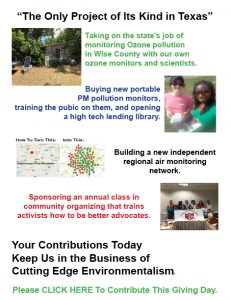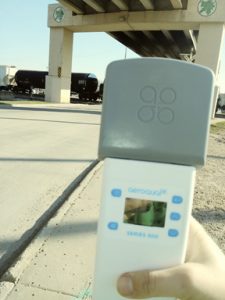Posts by jim
The North Texas Clean Air Network Gets an Unanimous Vote in its First Dallas City Hall Test…But Staff is Still Resisting
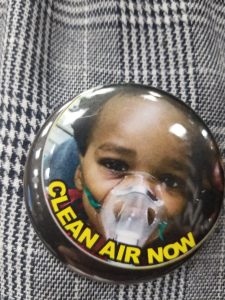 Rebuking its own staff’s misinformation campaign, the Dallas City Council’s seven-member Quality of Life Committee voted unanimously at its Monday morning meeting to recommend joining the North Texas Clean Air Network.
Rebuking its own staff’s misinformation campaign, the Dallas City Council’s seven-member Quality of Life Committee voted unanimously at its Monday morning meeting to recommend joining the North Texas Clean Air Network.
But in an unusual move, staff requested and received an almost three-month delay in scheduling a full city council vote on endorsing the new local air monitoring system. It won’t be until December 5th when the entire council gets briefed on the Network, and December 12th when they actually vote on whether to join. That’s a very long gestation period for a measure that just passed in Committee 7-0.
Staff claimed they wanted the long pause because of what they said were questions about how the city would participate in the Network and what provisions were necessary to get access to monitor locations like….utility poles. Citizens might be forgiven for suspecting the real reason for the three-month delay is to give staff time to find some new “fatal flaw” in the network and scuttle the whole thing before it ever comes up for a vote. If one listened hard enough, you could hear the startled disbelief in staff’s comments when the yes vote came down, despite every outward sign pointing to that outcome.
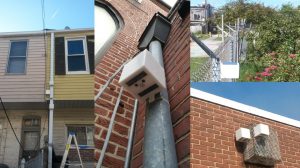 When one considers there was a Dallas city staffer at just about every meeting that led up to the creation of the Network, that these meetings began over a year ago, and that this specific presentation and vote has been scheduled for the Council’s review since August, it’s really quite incredible that staff admits they’ve spent no time thinking about how to implement this proposed policy within the city limits. Maybe because they’ve spent so much time trying to shoot it down.
When one considers there was a Dallas city staffer at just about every meeting that led up to the creation of the Network, that these meetings began over a year ago, and that this specific presentation and vote has been scheduled for the Council’s review since August, it’s really quite incredible that staff admits they’ve spent no time thinking about how to implement this proposed policy within the city limits. Maybe because they’ve spent so much time trying to shoot it down.
As late as the Friday before Monday’s vote staff was still at it, sending out a memo to Committee members downplaying the need for any regional network, conveying regulatory-correct but scientifically-misleading language about local Particulate Matter pollution levels, and writing one of the oddest sentences we’ve ever seen associated with air quality monitoring. In dismissing the formidable capabilities of the kind of low-cost high tech sensors the Clean Air Network will be using, Dallas Assistant City Manager Joey Zapata concluded, “These low-cost air sensors present new opportunities for uses beyond regulatory monitoring but are not yet able to provide direct measurements of real-time health impacts.“
That’s because that’s not what air pollution sensors or monitors do. None of them. Nada. Zero. Not even the really big and expensive ones the City currently operates for the State and EPA. They can only measure what levels of PM pollution are in the air you’re breathing, not what cancers, birth defects, strokes, heart attacks, diabetes problems, IQ loss, dementia or other illnesses that PM Pollution are causing “in real time” in your body as you breathe it in. No such Star-Trek-like technology exists.
In the real world researchers take the PM measurements recorded by sensors and correlate them to rates of illness. It’s a branch of science called epidemiology. The staff memo manages to completely confuse two wildly different scientific methods in a stunning, head-shaking way. It’d be flat-earth funny if it wasn’t, you know, the official position of Dallas City staff on the subject. Then it just becomes embarrassing.
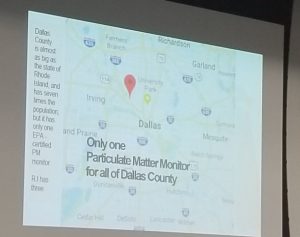 But whatever doubts about the Network staff tried to infect the council members with, they seemed to vanish once UTD Physics Professor Dr. David Lary and Downwinders’ Jim Schermbeck, representing the DFW Air Research Consortium, gave their 35-minute presentation on the Network.
But whatever doubts about the Network staff tried to infect the council members with, they seemed to vanish once UTD Physics Professor Dr. David Lary and Downwinders’ Jim Schermbeck, representing the DFW Air Research Consortium, gave their 35-minute presentation on the Network.
A roomful of “Clean Air Now” button-wearing supporters also helped the cause considerably. Thanks to everyone who came on an early Monday morning to make sure the Committee did the right thing. Thanks also to everyone who sent in emails to the Committee via our prepared Citizen Action website feature.
That combination of grassroots support plus technical expertise is one of the things that’s so impressive about this bottom-up approach, and it paid off again in the Committee meeting. Schermbeck made the case for change, Lary gave the details of how to build that change, monitor by monitor.
D Magazine published an online piece Monday morning that provides a point-by-point rationale for why this Network is A Big Idea Whose Time Has Come. Basically Big, Expensive and Slow has been replaced with Small, Cheap and Fast and it’s democratizing air quality information. All of that was included in the Committee presentation, plus examples of how it could have made a difference in the real world during a past crisis like the Sunshine Recycling Fire of December last year in West Dallas.
Both Plano and Dallas County officials have already said they’re onboard with the Network and may act to ratify the founding documents in their jurisdiction before the scheduled December Dallas vote. By the end of the year a new 21st Century regional air monitoring system, driven by local expertise, controlled by local governments, and designed to promote public health could become a reality.
But citizens may still have to fight to see it happen. In an ironic twist, the same staff that has been opposing the idea of Dallas joining the Network is now in charge of writing the briefing paper for the Council to explain why it’s a good idea. Bets are already being taken on how well they succeed.
ARC’s Network presentation was only half of an interesting compare and contrast exercise looking at two local projects using air sensors in two very different ways that Chair Sandy Greyson had arranged for the Committee.
The other half was a presentation by the Texas Nature Conservancy outlining their city staff-supported “resiliency” (i.e. Rockefeller) project, the “Breathe Easy” study proposing to place a PM and ozone monitor for two years at nine DISD schools that already see high student asthma and absenteeism rates, all below Interstate 30. Breathe Easy has already started spending money and needed no vote…although it was the first time any Council Committee had been briefed on it.
The study was supposed to get started back in August with the beginning of the school year but the nine schools haven’t been announced yet and so no monitors have been installed. Since the 2018-19 academic year is designed to provide a “baseline” of student asthma health, the study has already missed its chance of getting any data during the worst summer for ozone pollution in five years. It could take another month or longer to name the schools and wire-up the monitors. It’s uncertain how much this gap of missing information diminishes the value or definition of a baseline to which three specific intervention efforts are to be measured against beginning in the 2019-20 academic year.
Those intervention efforts include vehicle idling policies at or near schools, screens of vegetation between the 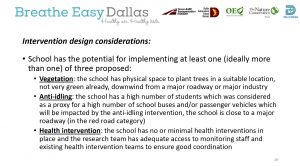 street and school, and in-school asthma therapies. The question being posed by the study is whether these intervention efforts have any impact on school-site pollution levels and therefore student asthma or absenteeism rates that can be measured.
street and school, and in-school asthma therapies. The question being posed by the study is whether these intervention efforts have any impact on school-site pollution levels and therefore student asthma or absenteeism rates that can be measured.
There’s certainly no harm in doing this study, but… its about ten years behind the times and spends a lot of money to tell us what we already know.
For example, we know DFW children’s asthma levels are higher than the national average. In their presentation, the TNC uses the 2009 Cook’s Children’s Hospital study made infamous by Downwinders almost a decade ago. That study contains the map showing a huge diagonal swath of childhood asthma running the length of Tarrant County that almost exactly syncs-up with the prevailing pollution plumes from the three Midlothian cement plants. Downwinders used that map time and again to prove the impact of the cement plants on downwind health during our Green Cement Campaign.
We know asthma is worse in minority communities. Many green groups were speaking out about this fact during the first wave of Environmental Justice activism during the 1990’s and have never stopped. What’s interesting is that TNC and the staff never ever talk about WHY this is a fact. It’s like they consider it an inherent genetic defect.
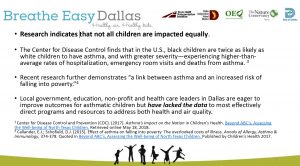 One reason might be that the Dallas City Hall staff now feigning concern for sick black kids is the same crew responsible for actively pressing racist zoning and land use planning in black and brown neighborhoods, like their predecessors before them.
One reason might be that the Dallas City Hall staff now feigning concern for sick black kids is the same crew responsible for actively pressing racist zoning and land use planning in black and brown neighborhoods, like their predecessors before them.
It was only last March when they were recommending approval for those two new batch plants in Joppa. Only last February when they recommended the Ash Grove Cement Silo in West Dallas. Before that they approved the move of the Argos batch plant from trendy Trinity Groves to a location next to a school in West Dallas.
Why do black kids have higher asthma rates in Dallas? Perhaps because the City of Dallas has designed it that way for over a century.
There is not a single note of contrition about this contradiction in the TNC or staff’s presentation on its Breathe Easy project. No “we’re sorry for putting people and polluters way too close in minority neighborhoods.” No “we’re going to do better from here on out – not just with these studies, but with actual policy.” No change in behavior, or even why there might need to be one, is ever discussed.
Those supporting the Breathe Easy study – or any other collaboration with the the Office of Environmental Quality and Rockefeller Sustainability – should understand they’re aligning themselves with a bureaucracy that’s been at the forefront of making the pollution problems in Joppa and West Dallas worse. And now the same bureaucracy wants to “study” the problem they helped make by testing out three piecemeal approaches to reducing exposure, rather than looking at how institutional changes could bring more fundamental and lasting solutions.
In the end, a year of intervention strategies at your school does little lasting good if you walk home through a polluted  neighborhood whose industries have been given a blank check by city staff.
neighborhood whose industries have been given a blank check by city staff.
We know reducing exposure to PM pollution improves your health. Lots and lots of studies show that.
We know which specific strategies work to reduce PM pollution. Buffer zones, vegetation screens, inside air filters, pollution controls, electrification of vehicles – all of these have been examined by researchers and found to reduce PM pollution levels. Even the Nature Conservancy cites the empirical success of tree planting in reducing pollution based on a past study. We don’t need a new study to tell us these strategies are effective. We need more money to implement them.
What the Breath Easy study seems to want to acquire is a new number – A, B and C intervention strategies reduce student asthma attacks/absenteeism by X, Y and Z amounts.
But can that be a meaningful, scientifically-robust number now that you only have an abbreviated baseline that excludes summer? Can it be meaningful if you only spend a year testing intervention strategies, including growing vegetation screens? Even applying copious amounts of Miracle Gro, your trees are not going to get that tall in 12 months.
Using all of TNC’s own data, a convincing case can be made that the $300,000 + being spent on this study could have been better spent on buying trees for those nine schools and installing them as PM screens. But that would have just reduced PM pollution. It wouldn’t have produced a study for the Rockefeller Foundation.
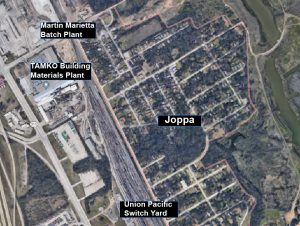 A dense regional Network of air monitors will begin to expose the deep disparities in pollution burdens in Dallas and elsewhere. It’ll provide a map to black and brown neighborhoods they don’t have now, providing further evidence that what you breathe in Dallas depends on where you live in Dallas. There’s plenty of indications this is the real disparity that Dallas City Hall staff are concerned with – even more than higher rates of black childhood asthma.
A dense regional Network of air monitors will begin to expose the deep disparities in pollution burdens in Dallas and elsewhere. It’ll provide a map to black and brown neighborhoods they don’t have now, providing further evidence that what you breathe in Dallas depends on where you live in Dallas. There’s plenty of indications this is the real disparity that Dallas City Hall staff are concerned with – even more than higher rates of black childhood asthma.
The curtains are about to part and provide a much clearer picture of how Dallas’ institutional racism has poisoned its own residents. It behooves everyone who calls themselves an environmentalist in Dallas in 2018 to commit to changing that picture, not just studying it.
GIVING DAY PAYS FOR COMMUNITY ORGANIZING

After almost 30 years of illegally dirty air, Downwinders at Risk still employs the only full time staffer devoted exclusively to DFW air pollution problems.
And they do it with your contributions.
CLICK HERE
TO SECURELY CONTRIBUTE TO DOWNWINDERS
What Your
Giving Day Contribution Pays For:
Community Organizing in Joppa
 From its founding Downwinders has fashioned itself as a grassroots group employing basic community organizing principles.
From its founding Downwinders has fashioned itself as a grassroots group employing basic community organizing principles.
This makes us different than most other green groups, who see themselves advocating for causes. We advocate on behalf of people in neighborhoods and towns who are getting shat on by industry, elected officials, bureaucracies, or all of the above.
The latest example is in Joppa, Dallas oldest Freedman’s township.
Surrounded on three sides by heavy industry and freeways, and on the fourth by a landfill and the Trinity River, Joppa is a small neighborhood that looms large in Dallas history. It’s where “South Dallas” began.
We were invited by Joppa residents to use our new portable PM monitors to sample their air prior to the March City Council vote on two new batch plants. That sampling helped defeat those batch plants.But instead of continuing to play “whack-a-mole” with industrial facilities that keep popping up in Joppa, we  proposed a sustained effort to start undoing the environmental racism that brings them to that community in the first place. We wanted to address the underlying problem, not just the symptoms.
proposed a sustained effort to start undoing the environmental racism that brings them to that community in the first place. We wanted to address the underlying problem, not just the symptoms.
Residents and their supporters hammered out the idea of an“Environmental Preservation District” that would systematically address each of the environmental threats identified by the community, including buffer zones, new pollution controls on local industry, and continuous air monitoring.
And so this coming Monday evening Downwinders will be hosting the first meeting of the “Let Joppa Breathe” Alliance, a new network designed to help press the agenda of the Joppa Freedman’s Township Association citywide and win structural changes.
 This isn’t going to be a short fight. It’ll take years. It’ll take a lot of focused energy. It’ll take a lot of people. But the goal of being able to use a reborn Joppa as a model of how to undo environmental racism in other parts of the City is worth it.
This isn’t going to be a short fight. It’ll take years. It’ll take a lot of focused energy. It’ll take a lot of people. But the goal of being able to use a reborn Joppa as a model of how to undo environmental racism in other parts of the City is worth it.
No other green group in DFW has the resources or the mandate to carry out this kind of long-term community organizing campaign. With you contributions, we’ve been doing them for almost 25 years.
GIVING DAY PAYS FOR INSTITUTIONAL CHANGE
We don’t have an home office
in Austin, or Washington, or NYC.
Our only office is right here in DFW.
We don’t have a national agenda.
We have local agendas that have national impacts.
CLICK HERE
TO SECURELY CONTRIBUTE TO DOWNWINDERS
What Your Giving Day Contribution Pays For
Institutional Change:
Creation of the North Texas Clean Air Network
 currently operate.
currently operate. But we also wanted to make sure it would be a tool for citizen empowerment, so we insisted on having public and public health advocate seats on the board overseeing the new network.
But we also wanted to make sure it would be a tool for citizen empowerment, so we insisted on having public and public health advocate seats on the board overseeing the new network.
Each governing entity joining the network appoints a staff person or elected official. But they also appoint a public representative as well.

 If there’s one critical difference between Downwinders and most other green groups, it’s that we know process is as important as policy. You can improve policy, but the really lasting changes occur when you also change the process itself. When you commit institutional change on behalf of citizens.
If there’s one critical difference between Downwinders and most other green groups, it’s that we know process is as important as policy. You can improve policy, but the really lasting changes occur when you also change the process itself. When you commit institutional change on behalf of citizens. This new independent network will eventually supersede the obsolete system currently run by the state and federal government. It’ll become the default way DFW residents check their air. It’ll bring challenges and changes to environmental enforcement, zoning and land use planning, and even the timing of traffic lights. It gives citizens and local governments a powerful new tool.
GIVING DAY PAYS FOR CITIZEN SCIENCE

Downwinders is a entirely local group,
run by board members who live in DFW,
and funded by local contributions. Like yours.
CLICK HERE
TO SECURELY CONTRIBUTE TO DOWNWINDERS. THANKS
What Your Contribution Pays For:
Citizen Science
In the past 18 months, Downwinders at Risk has become the leading sponsor of environmental Citizen Science projects in DFW. Your Giving Day contribution today will help us pay for the following:
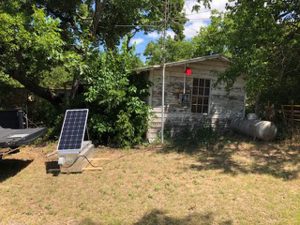 The Wise County Ozone Project
The Wise County Ozone Project
 powered portable ozone monitoring station (ATLAS) so we could deploy them anywhere in Wise County. This July they were installed on site and now a non-profit clean air group is performing the air quality monitoring duties of the state and federal government – all for about $13- $14,000 dollars.
powered portable ozone monitoring station (ATLAS) so we could deploy them anywhere in Wise County. This July they were installed on site and now a non-profit clean air group is performing the air quality monitoring duties of the state and federal government – all for about $13- $14,000 dollars. This is the purest piece of citizen science we’re committed to. We’re not sure what we’ll find. But we’re not afraid to take on a basic job government is supposed to be doing.
This is the purest piece of citizen science we’re committed to. We’re not sure what we’ll find. But we’re not afraid to take on a basic job government is supposed to be doing.Portable Monitors: Training and Lending Library

Shannon Gribble and Cresanda Allen on a monitoring run in Joppa
Earlier this year we bought two portable Particulate Matter (PM) monitors that had just come onto the market from a
New Zealand company, Aeroqual. Calibrated at the factory, these monitors were better than anything else on the market for the price – $1600 each.
Shortly after taking delivery, Joppa residents asked us to bring them to that neighborhood to sample what the air they were breathing was like even before two proposed new batch plants opened there. Our monitors recorded levels of PM pollution much higher than those found at the only official PM monitor in Dallas County hosts, nine miles away – the same monitor city staff was trying to use to say how clean Joppa air was. Our results sealed the defeat the new Joppa batch plants.
With the help of the Dallas Sierra Club and others contributing to the May 22nd Joppa benefit, we were able to buy a third Portable PM Monitor for use exclusively in Joppa, where it now resides 24/7. This December we’ve budgeted to buy two more, giving us a total of five by the end of the year.
Meanwhile, EPA and Areoqual established a national partnership for air quality monitoring, enhancing the credibility of our monitors and our results.
 This Saturday, members of our PM Committee will be hosting free public training sessions on how to use our portable monitors in the field. When you’ve completed three field trips with our team, we’re giving you the chance to ‘”check-out” the portables for your own use or to further help us research local PM levels at specific sites.
This Saturday, members of our PM Committee will be hosting free public training sessions on how to use our portable monitors in the field. When you’ve completed three field trips with our team, we’re giving you the chance to ‘”check-out” the portables for your own use or to further help us research local PM levels at specific sites.
Today is Giving Day…..
New Study Finds PM in Placentas

Scientists already knew that maternal exposure to PM pollution had the potential to harm fetal development. Studies have documented higher rates of Autism, ADHD and other developmental diseases in close proximity of freeways and other large sources of PM pollution. But until now researches hadn’t actually identified how PM harmed newborns.
According to a study presented last week at the European Respiratory Society’s (ERS) international congress in Paris, researchers have found the first evidence that particles of air pollution travel through pregnant women’s lungs and lodge directly in their placentas.
Using an optical microscope, they examined the placentas of five non-smoking women who all delivered healthy babies. They found 72 dark particles among 3,500 cells and then used a powerful electron microscope to examine the shape of some of the particles. They looked like the sooty particles found in macrophages in the lung.
One of the study’s authors, Dr Lisa Miyashita of Queen Mary University of London, ruled out almost any other substance, “We can’t think of anything else they could be. It is very evident to us they are black sooty particles.” Dr Norrice Liu, also at Queen Mary University of London and part of the team stated, “We also know that the particles do not need to get into the baby’s body to have an adverse effect, because if they have an effect on the placenta, this will have a direct impact on the foetus.”
Almost every effort examining the health effects from PM pollution over the last decade have all concluded there’s no level of exposure that’s not capable of leaving some harm behind. What this new study indicates is that many of us may already be harmed by exposure even before we’re born and that may make additional exposure that much more harmful.
Just this past month two new reports were published that linked PM pollution to significant IQ loss and diabetes.
In separate research, also presented at the Paris congress, researchers found that children with early onset and persistent asthma fared far less well in education than those without the condition.
The study, conducted over 20 years in Sweden, showed that children with asthma were three and half times more likely to leave school at the age of 16 with only basic education and were also twice as likely to drop out of university courses
Take 60 Seconds and Urge Dallas City Council Members To Approve Joining A New Regional Air Monitoring Network
CLICK HERE
TO SEND A PREPARED EMAIL TO DALLAS CITY COUNCIL MEMBERS URGING DALLAS JOIN THE NEW NORTH TEXAS CLEAN AIR MONITORING NETWORK
Next Monday, September 24th, the Dallas City Council’s Quality of Life Committee will have a chance to take the City’s air quality tools into the 21st Century.
Committee members will view a presentation on the fledgling North Texas Clean Air Network and be asked to join Plano and Dallas County in signing-on to the state’s first independent air monitoring network. A yes vote will send the decision to the full City Council.
 There’s no mandatory fee to join. Every city, county or other governmental entity gives what it wants. This slow cook approach has already put 50-70 new high-tech-low-cost monitors in play from Plano to Joppa over the past year.
There’s no mandatory fee to join. Every city, county or other governmental entity gives what it wants. This slow cook approach has already put 50-70 new high-tech-low-cost monitors in play from Plano to Joppa over the past year.
Fueled by expertise at area research universities and constructed with the help of local officials and environmentalists, the Clean Air Network treats air quality monitoring as a public health tool to be run as a public utility.
Once in place, dense grids of real time Particulate Matter pollution monitors can have lots of benefits and uses. They can act as 24/7 fence line mon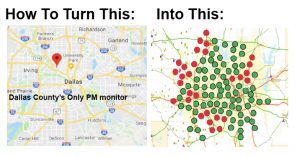 itoring for industrial facilities, help determine the right timing of traffic lights to reduce air pollution, map pollution disparities neighborhood by neighborhood, and correlate pollution burdens with public health. Because of its potential to inform and create policy, this air monitoring network represents one of the most significant environmental advances for DFW this century.
itoring for industrial facilities, help determine the right timing of traffic lights to reduce air pollution, map pollution disparities neighborhood by neighborhood, and correlate pollution burdens with public health. Because of its potential to inform and create policy, this air monitoring network represents one of the most significant environmental advances for DFW this century.
Please help make sure the Network clears this first political hurdle to full City Council approval. Send a quick “click and send” email to every member of the Dallas city council’s Quality of Life Committee members telling them you support Dallas joining the North Texas Clean Air Network. You can add your own message too.
Thanks.
MAY 22 FREE Citizen-Science Training for Portable Air Monitoring
SATURDAY, SEPT 22
Session 1:
10:30 am -1 pm
Session 2:
2pm to 5 pm
Goodwork Co-Working Space
1808 South Good Latimer/Dallas
For the first time, Downwinders is offering members of the public the chance to learn how to take air quality samples with one of our Aeroqual Series 500 portable Particulate Matter monitors – the monitors that helped defeat the proposed Joppa batch plants back in March.
For this first introductory lesson, there’s a 45-60 minute classroom presentation followed by 90 minutes in the field actually taking readings with the machines. The field trips will all be aimed at helping Downwinders assemble a growing data base on Dallas PM levels.
This customized training has been put together by Downwinders’ PM Science Director, Dr. Tate Barrett of UNT, as well as Cresanda Allen and Amanda Poland of our PM Committee. There’s no charge to attend. Lunch won’t be served, so bring some snacks and since we’re going out in the filed, you’re advised to wear comfortable shoes and clothes.
At the completion of this first hands-on training, participants will be given a  certificate that classifies them as “apprentice” level citizen scientists. This allows them to sign-up and go out on individual portable monitoring trips with members of the PM team in the weeks ahead. After two such outings with the team they’re classified as a Citizen Science “Researcher” and assigned more responsibilities.
certificate that classifies them as “apprentice” level citizen scientists. This allows them to sign-up and go out on individual portable monitoring trips with members of the PM team in the weeks ahead. After two such outings with the team they’re classified as a Citizen Science “Researcher” and assigned more responsibilities.
After three such excursions with team members, they’re classified as an “Investigator” and are eligible to check put the monitors for their own projects or help contribute to group efforts. In effect, we’re creating a lending library of portable air monitors open to anyone willing to go through the training.
On Saturday the 22nd we’re offering two training workshops:
Training Session #1 10:30am – 1pm
Training Session #2 2 pm – 5 pm
Both sessions will be conducted at the GoodWork Co-working space at 1808 South Good-Latimer, Downwinders’ home.
Participation is limited to let everyone get a chance to actually use the portables. To assure yourself a spot, please sign-up now by letting us know which session you want: downwindersatrisk@gmail.org, re:citizen science training.
New Study Links PM Pollution to IQ Loss
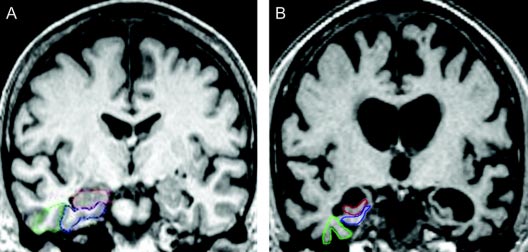
Underscoring how important this month’s event are is a new study from China that concludes exposure to Particulate Matter air pollution erodes a person’s IQ, especially in older people.
“Polluted air can cause everyone to reduce their level of education by one year, which is huge,” said Xi Chen at Yale School of Public Health in the US, a member of the research team. “But we know the effect is worse for the elderly, especially those over 64, and for men, and for those with low education. If we calculate [the loss] for those, it may be a few years of education.”
In some ways this latest research, published in Proceedings of the National Academy of Sciences (PNAS), only confirms earlier studies associating PM pollution with Dementia and other developmental diseases like Autism and ADHD. But it was the largest study yet to look at the impact PM has on cognitive abilities and it looked at people of all ages, not just students. 20,000 men and women were followed for four years and many other variables besides exposure to air pollution were ruled out as causes of the decline, including the inevitable decline of mental dexterity with age.
The more a person was exposed to dirty air, the more their intelligence suffered, with language skills suffering more than mathematical or analytical, and men more than women.
At the same time even short term exposure to air pollution was seen to have an effect on intelligence, a result with consequences for students taking tests or workers attempting to passing certification exams.
Derrick Ho from Hong Kong Polytechnic University was quoted in a Guardian article stating his own research group had similar preliminary findings in their work. “It’s because high air pollution can potentially be associated with oxidative stress, neuroinflammation, and neurodegeneration of humans.”
Specifically, exposures to pollutants such as carbon monoxide (CO) and particulate matter prevent proper blood flow and could affect the flow of oxygen to the brain, which in time, affect cognition. Long-term exposure of these pollutants can lead to lesions in the brain’s white matter, which is dangerous for cognitive skills.
The study has worrying implications for neighborhoods like Joppa and West Dallas that are crowded next to PM polluting industries and freeways. Residents from those communities often start out with material or social disadvantages that limit their opportunities. Constant exposure to a toxin that robs them of IQ points makes things even worse. It’s one more thing that can trap them in downward spiral.


